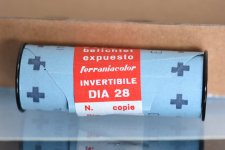- Messages
- 28
- Name
- David
- Edit My Images
- Yes

Popped over to the local film lab today with two rolls of 120 film that have been rolling about in my gear box for a couple of years. One, an Ilford FP4 film I had put through a 1930s Voigtlander Bessa and another I’d found in a camera purchased during the lockdown, a roll of FERRANIACOLOR INVERTIBILE( see pic).
The chap looked at it and informed me he had seen nothing like it and disappeared to do an internet search. On his return said he could find nothing therefore he would not attempt to process it for:
- Some older colour films literally dissolve in modern processing and he did not want to be responsible for destroying the Film.
- If it did dissolve in the tank all the solution would need to be replaced and the tank cleaned.
What to do?
Is there a company that undertakes this form processing?
I really do not want to waste this film as there is always a small possibility of finding some interesting exposures.
Last edited:

